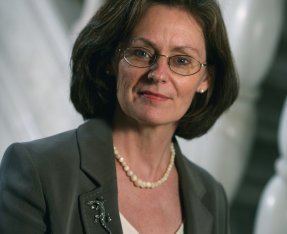Name Christine Holt Spouse Bill Harris | ||
 | ||
Born 28 August 1954 ( 1954-08-28 ) Notable awards Elected Member of EMBO (2005), Fellow of the Academy of Medical Sciences (2007), Fellow of the Royal Society (2009); Remedios Caro Almela Prize in Developmental Neurobiology (2011). Alma mater University of Sussex, King's College London | ||
Institution University of Cambridge | ||
Christine Elizabeth Holt FRS, FMedSci (born 28 August 1954) is a British developmental neuroscientist.
Contents

She has been Professor of Developmental Neuroscience, University of Cambridge, since 2003 and a Fellow of Gonville and Caius College, Cambridge University, since 1997.
In 2009, she was part of an international team that received a "Human Frontiers Science Program (HFSP) grant to develop molecular probes that will help researchers better understand the "cellular GPS" system that guides neurons to create a properly wired nervous system."
Julia christine holt talent show
Biography
In 1977, Christine Holt received a Bachelor of Science (Honors) in biological sciences at the University of Sussex. She then completed her Ph.D. in zoology with John Scholes as her mentor at King’s College London in 1982 Her first publication “Cell movements in Xenopus eye development” in Nature magazine in 1980 highlighted the movements of the cells during development based on the eye polarity. From 1982 to 1986, she was a postdoctoral fellow in the Physiology Department at Oxford University and the Biology department of University of California San Diego (UCSD). Her mentors were W.A. Harris and Colin Blakemore.
In 1986, while she was an assistant research biologist and lecturer at University at California at San Diego, she received the McKnight Scholar Award, which granted her $30,000 annually for 3 years. She was then studying the development of frog’s visual system in early embryonic period. She expressed interest in “the basic mechanisms that govern how the vertebrate brain becomes wired up in the highly specific and complex way that it does”. She was also granted an Alexander von Humboldt award, which allowed her to perform research in Germany in 1987.
She joined the faculty at UCSD in 1989, and her main research focus was early brain development. She was particularly interested in the visual system and the mechanism in which axons from retina grow to specific brain cells. During this period, she performed experiments to understand the role of adhesion molecules in axon guidance by assessing the loss of N-cadherin and integrins, two of the three types of adhesion molecules, on embryonic brain. In 1991, she was awarded $200,000 as Pew Scholar to fund her research over four years.
In 1997, she continued her research at Gonville & Caius in the University of Cambridge. She was elected a member of the European Molecular Biology Organization in 2005, a fellow of the Academy of Medical Sciences in 2007, and fellow of the Royal Society in 2009. She was awarded the Remedios Caro Almela Prize for Research in Developmental Neurobiology in 2011.
Since 2003, she holds the position as the Professor of Developmental Neuroscience in the Department of Physiology, Development and Neuroscience (PDN) at the University of Cambridge . Her research interests continue to be the mechanism of axon guidance in axon growth and synaptic specificity in the development of complex brain networks. The new cone growth occurs in the beginning of regeneration of axon, which may be the result of an axotomy, and she is credited to be the pioneer of the idea that "proteins synthesize and degenerate at local level in the cone of growth". This process is required for efficiency in growth and for signals in axon orientation. She also looked at signalling molecules during axon growth such as ephrin-B and EphB1 in the formation of the optic chiasm . In addition, her studies also found that netrin-1, DCC, laminin-1 are key players in axon guidance from the retina . For example, netrin-1 is both a chemoattractant and a chemorepellent for many classes of axons, and her 1997 study shows that the growth cone of spinal neurons is chemoattractive to netrin-1 yet chemorepulsive when cAMP is present. Therefore, the presence of netrin-1 may serve as a cue for axonal growth. Further studies have also found that netrin receptor DCC and laminin-1 are other factors related to netrin-1 work in axon guidance. Christine also currently collaborates with Giovanni Armenise-Harvard laboratory of axonal neurobiology . The lab research focuses on axon guidance with emphasis on the role of microRNAs and non-coding RNAs for their part in axon regrowth and rewiring and a possible link to cancer of the nervous system. Her research provides leads for future therapies for nerve damage and neurodevelopmental disorders.
Personal life
Her husband is W.A. Harris (FRS). Beyond teaching and research, she listed her other interests as “wildlife, walking, music, family”.
